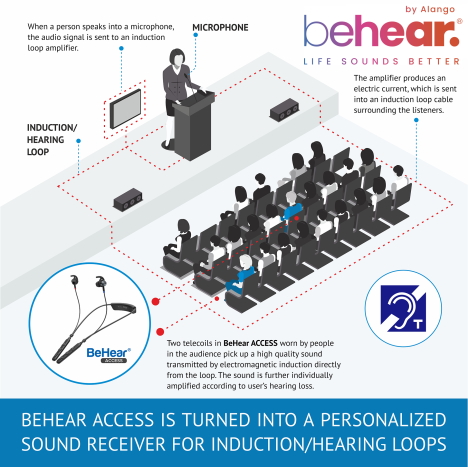Get Big Savings by Acting Today!
These days many people are confined to their homes. Those with hearing loss, especially those aged 65 and older, experience more frustration than ever as they struggle to deal with the following challenges:
Face-to-Face Communication
Being able to communicate with a hearing-impaired person without raising your voice or, from the impaired side, without asking the speaker to talk louder, clearer, etc., may greatly reduce otherwise quickly accelerating stress and mutual antagonism.
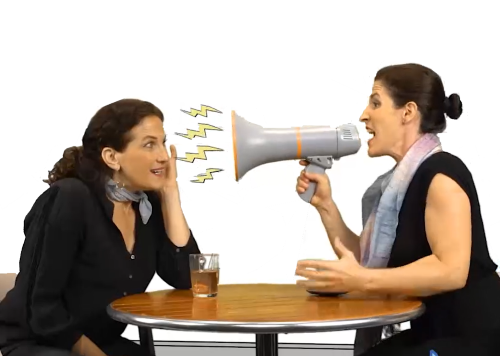
Wear & Hear products can help keep the family peace by enhancing and clarifying speech.
Mobile Phone Conversations
Many seniors are prevented from communicating in person with their families and are relying on phone conversations to stay in touch. For those with hearing loss it is more difficult to understand phone speech because they do not have the visual cues afforded by in-person conversation.

Also, phone amplification options and the sound quality of modern phones are limited. The sound options of mobile phones may also not allow suitable personalization.
Wear & Hear products enable phone calls with high quality sound optimized for the user’s specific hearing loss. They can even slow down the voices of fast talkers, making them more intelligible, without asking them to do so.
Watching Television
People are watching more television these days. Being able to comprehend TV dialogue at normal volumes will add to the watcher’s enjoyment, AND be appreciated by other house dwellers / neighbors.
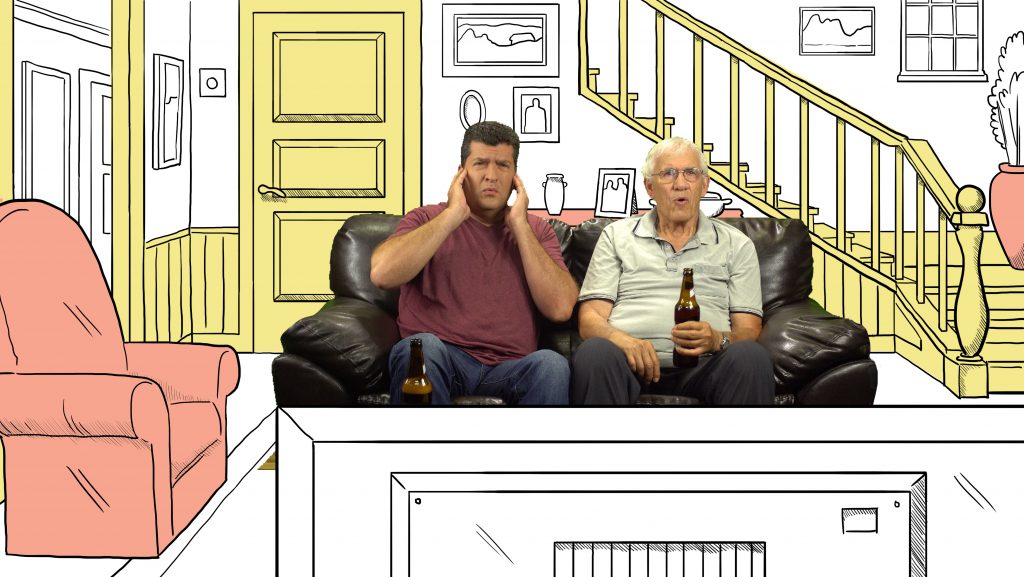
Wear & Hear products work as top-quality TV listening systems with personalized sound.
Alleviating Stress with Music
Stress is a big problem for people confined to a small space. Quiet, calm music is a great relaxation tool when you can hear it as it was meant to be heard. Unfortunately, hearing impaired people are often deprived of this. Listening and enjoying quiet music requires good hearing; otherwise, it either cannot be heard at all, or it is too loud. There is simply no comfortable listening level.
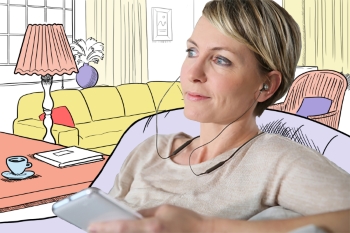
Wear & Hear products allow people to reduce their stress by enhancing audio to suit their unique hearing profile.
Do Yourself a Favor
These days, when staying connected is more important than ever, we’re offering big discounts off our personalized hearing products. Visit our on-line store or contact a local Wear & Hear distributor to benefit today.
How to Alleviate Unnecessary Stress for the Elderly During the Pandemic
The Most Vulnerable Age Group to Catch the Virus is Also the Group Most Likely to Suffer from Hearing Loss

♦ Getting sick enough to see a health professional during these days of the Corona virus pandemic is stressful in its own right, but inability to hear the staff’s diagnosis or treatment strategy because you left your hearing aids behind is truly frustrating. What can be done?
While not being directly related, there is a strong correlation between the severity of symptoms for people infected with COVID-19 and hearing loss rates for different age groups. Both worsen quickly with age. Logically, this leads to a direct link between the number people being infected and admitted to hospitals, and the number of hospital patients with high levels of hearing loss.
Hearing aids are very expensive devices that are easy to lose and easy to fall into disrepair. Few people take their hearing aids with them when they rush to noisy emergency rooms, eventually limiting their abilities to communicate with the hospital staff and get the proper treatment. Not being able to hear and understand the situation also contributes to a condition called “delirium” which is an acute disturbance of mental abilities. This hospital-induced delirium typically results from the combination of stress from poor health, disorientation from being in an unfamiliar environment with strangers, disruption of routine, and absence of familiar faces.
We believe that Alango Wear & Hear products can provide a hearing enhancement solution that is affordable, durable, and easy to use in hospital conditions. It is also multi-functional, allowing patients to better understand the medical staff, communicate over the phone, enjoy music, and watch TV.
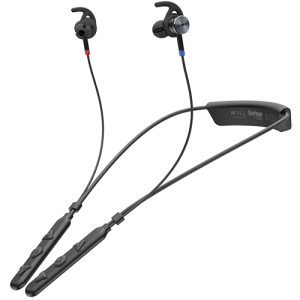
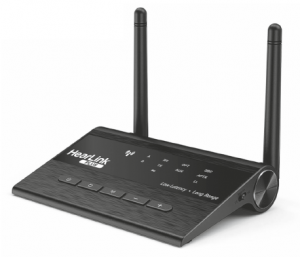
The BeHear ACCESS headset can be paired with HearLink® PLUS, a Bluetooth® transmitter that streams audio directly from the television’s analog or digital (optical) sound source to the viewers ears. Ambient noises, room reverberation, and other types of sound interference which hamper intelligibility of speech and music appreciation are eliminated. Other residents of the hospital ward (or household) will appreciate the fact that the TV volume doesn’t disturb them. The transmitter pairs seamlessly with Wear & Hear assistive hearing headsets, ensuring that each viewer benefits from personalized audio that can be fine-tuned in real-time using the dedicated W&H BeHear smartphone app.
To get our stories sent directly to your inbox, register here.
World Hearing Day: March 3
This year’s theme is “Hearing for life: Don’t let hearing loss limit you”
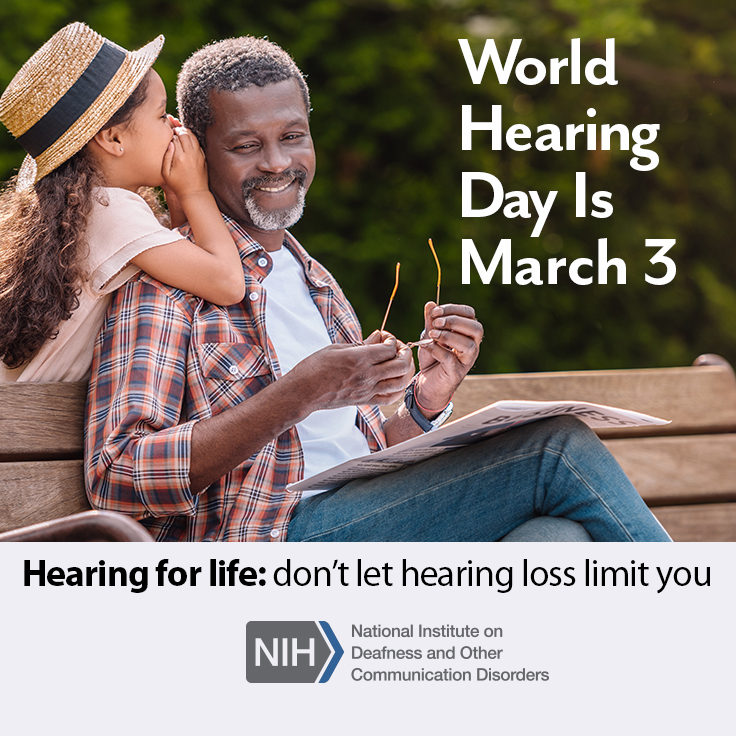
Every year on March 3, WHO, the health agency of the United Nations, engages organizations in World Hearing Day public awareness activities. This year’s theme, “Hearing for life: Don’t let hearing loss limit you,” highlights the importance of hearing loss prevention and timely and effective interventions for those who are deaf or hard-of-hearing.
We at Alango – Wear & Hear are pleased to join in this effort. Read the full article from the National Institute on Deafness and Other Communication Disorders by clicking this link. Learn more about age-related hearing loss by clicking this link. Do something about your own hearing loss by trying out our affordable, personalizable, stylish, multi-functional hearing amplification products using the 30-day “Buy & Try” policy in our Web store.
Alango Founder Describes His Vision for Better Hearing
What inspired a computer engineer with expertise in sound enhancement to tackle the “silent epidemic” of untreated hearing loss?
Dr. Alexander Goldin, the Founder and CEO of Alango Technologies, was recently interviewed by Tyler Gallagher of Authority Magazine. The following is an excerpt from the full article, which is posted on both Medium.com and Thrive Global.
Dr. Goldin states: Here is a sad statistic from World Health Organization: in 2001, roughly when I started analyzing the situation, there were 250 million people worldwide with disabling hearing loss. Today, this number has increased to 466 million. And, it is estimated that by 2050 over 900 million people will have disabling hearing loss.
If we provide an affordable, self-administered solution to hearing loss, we will help children to succeed more in learning, adults to be more efficient at work, and the elderly to stay active and connected to other people. We will reduce the huge cost of unaddressed hearing loss and use that money to make other aspects of human life better, I hope.
Dr. Alexander Goldin, Founder & CEO at Alango Technologies
When asked What do you need to lead this technology to widespread adoption? Dr. Goldin responded:
“When people are asked about hearing loss and a treatment for it, they will answer “hearing aids” even though, as I mentioned earlier, worldwide adoption rates for hearing aids are incredibly low. We at Alango Technologies are creating a new category of hearing enhancement devices that are affordable, versatile, stylish, and self-tunable. Unfortunately, most hearing-impaired users are not aware of this option. We need to inform them. And, after people hear about something new, it takes them a long time to start believing in it. We need to shorten this process and that is where we need help. I hope this interview will give us such help.
Bottom line: Won’t you help us in our efforts to get the word out? Share this article, or simply mention to someone who could benefit that affordable, versatile, stylish, and self-tunable hearing enhancement devices exist today. It’s bound to be life-changing.
Do You Think Your Hearing is Fine?
If you are between the ages of 20 and 69 – you probably suffer from hearing loss. But there is good news – you can check it by yourself and do something about it.
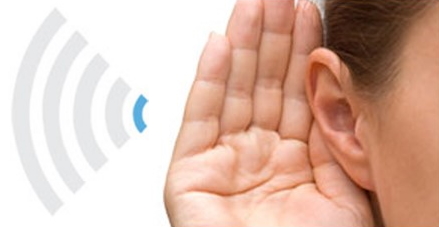
If you think your hearing is fine, think again. A federal study reports that about a quarter of the people between the ages of 20 and 69 who think their hearing is “good” or “excellent” are in fact showing signs of hearing loss.
Hearing loss is often attributed to noisy work environments, or to aging. The Centers for Disease Control and Prevention (CDC) reports that 24 percent of hearing loss is due to loud workplaces.
What surprised us was we found many people with evidence of noise-induced hearing damage who don’t have noisy jobs, who got that damage from their home or community.
Dr. Ann Schuchat, acting director of the CDC
Loud noises – from sirens to lawnmowers and rock concerts to sporting events – can permanently damage hearing. That damage builds up over time, and once it’s lost, it’s lost forever.
The study finds that the loss often starts early in life. Approximately 20 percent of Americans in their 20s have lost some ability to hear the softest sounds. The effect is much more pronounced in men than in women. And a quarter of people who have lost some hearing don’t even know it.
Hearing loss is especially problematic for older adults, who can find themselves socially isolated when they can’t hear what people around them are saying.
The CDC also notes that chronic exposure to noise has been associated with increased stress, anxiety, depression, high blood pressure, heart disease, distractability, and annoyance.
Bottom line: It’s best not to assume that your hearing is fine. The good news is it’s very simple to check it by yourself. There is a built-in hearing assessment in the BeHear NOW personalizable hearing amplifier (which also looks and functions just like a Bluetooth headset). With our 30-day “Buy & Try” return policy, you have nothing to lose. And with our upcoming “Black Friday” special offers there is no time like the present to do something about it!
How to Survive a Family Gathering When You Have Hearing Loss
5 tips for enjoying the upcoming holiday season when your hearing is impaired

Having hearing loss can sometimes make you feel left out of conversations.
It’s easy to turn down invitations to parties and events, or to withdraw from group conversations because of hearing loss, but it doesn’t have to be that way.
Here are 5 tips for enjoying the upcoming holiday season:
- Determine who might not know about your hearing loss. Make it a point to connect with those people during the celebration. Tell them about your hearing loss and that you want to hear what they have to say. Ask them to get your attention when they want to communicate. Try using this common “drill”: “Please look at me, speak slowly and forgive me if I ask you to repeat what you said.” Have a laugh about it. They will appreciate your thoughtfulness.
- Check your expectations, fears and concerns at the door. It’s Thanksgiving! The whole family is here, and you want nothing more than to participate in it all. You already know that the day will not go perfectly, and you may miss a lot of the news and conversation. That said, you can always get contact information for those with whom you wish to continue communicating. Emails, texts and cell phones now afford us a variety of convenient and accessible ways to communicate – just one more thing for which to be thankful.
- Double, or single-sided deafness? Location, location, location. Sit in the middle of the table and try your best to hear what’s going on. Or seat yourself at a good angle to at least see everyone. If you can, have some family members who know how to communicate with you (and who won’t place extraordinary demands on your hearing) sit near you so you can have your own conversation circle.
- Save the day for a family member with hearing loss. Let them know you know that they are hard of hearing and offer to help them communicate with others if they need assistance. You can be their translator – stand or sit near them to help with conversations. Make a point of spending some time chatting to make them feel part of the celebration.
- Try using a personalized hearing amplifier. A headset from the Wear & Hear line can give you the boost you need to take an active part in holiday conversations. These devices are self-tunable, lightweight, and very comfortable. When not in use, the magnetized ear buds will hold the headset in place on your chest (like a pair of glasses). They let you be in charge of your own hearing!
Induction Loops, Telecoils and BeHear ACCESS
The News
BeHear ACCESS, a Personalized Hearing Amplifier headset in the BeHear product line, incorporates telecoil receivers.
Function
Induction Loop Systems transmit wireless audio input via a magnetic field to telecoil receivers. These receivers are found in many hearing aids, some dedicated headphones, and, now, in BeHear ACCESS headsets. In an induction loop system there is no interference, no reverberation, no background noise, just the original signal transmitted directly from the input, whether that is the microphone on a podium, the audio system in a theater, the microphone the cashier is speaking into at the bank, or the music from the concert hall stage. This closed system provides people, especially those with hearing loss, an excellent way to hear voice and audio signals clearly, even in noisy places or when the sound source is far away.
Terminology
Induction Loop Systems were first introduced publicly in 1937 in a U.K. patent application for a system featuring what was then called a telephone coil. The term telephone coil has been shortened to telecoil or just T-Coil. Induction loops are also known as hearing loops, or simply “loops”.
Prevalence
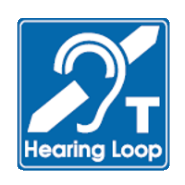
Induction loop technology is common in Europe and the U.K. and is universally accepted as the international standard for hearing access. Installed base is growing rapidly in the United States as organizations such as HLAA (Hearing Loss Association of America) and others press venues to become compliant with the ADA (Americans with Disabilities Act).
Typically, induction loop systems can be found in:
- Places of Worship
- Concert Halls
- Theaters
- Universities
- Government Offices
- Banks
- Ticket Kiosks
- Post Offices
- Airports
- Museums
Hearing Loop Demonstrations
The following two animated hearing loop animations and explanations are provided with thanks to www.hearingloop.org — an excellent resource for more information on this technology.
T-Coil Support in BeHear ACCESS
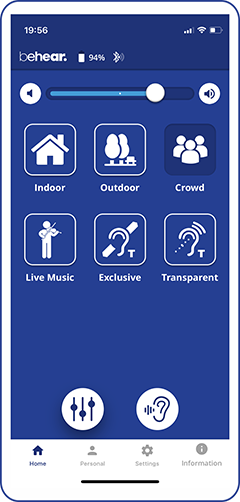
BeHear ACCESS T-coils can be activated wherever a loop system is installed. The wearer simply chooses either the T-Coil Exclusive or T-Coil Transparent mode (from the W&H BeHear app Home page, or by scrolling through the Hearing presets using the middle button on the right-hand control box). Exclusive mode allows only the direct signal from the T-Coil transmission to reach the wearer’s ears, while Transparent mode allows nearby important sounds (such as a companion’s voice) to be heard as well.
Each BeHear ACCESS headset incorporates two T-Coils that are perpendicular to each other, thus greatly decreasing sensitivity to the wearer’s orientation in the magnetic field of an Induction Loop System.
How to Hear Better in Noisy Places
- Do you sometimes have trouble following conversations in noisy places?
- Does it seem that restaurants play background music louder than they used to?
- Do you struggle to hear the speaker at the end of the dining or conference room table?
These situations are typically symptoms of mild-to-moderate hearing loss. While hearing aids may be the best solution for those who have a really hard time hearing in almost every situation, they may not be right for you.
Can Technology Help?
For those who have mild-to-moderate hearing loss the Wear & Hear line of personal hearing devices provide a completely personalized hearing experience. Important ambient sounds, peoples’ voices, and sounds from all audio sources are amplified, enhanced and adapted to suit individual hearing preferences.
Advanced technology based on input from four separate microphones integrated into a neck loop style Bluetooth headset cancels out distracting noise while amplifying important sounds. The result: improved intelligibility of speech, even in noisy places.
Companion App Provides Additional Functionality
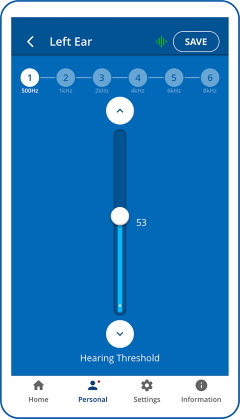
A free app, available for iPhone and Android, allows you to personalize the headset using an integrated hearing assessment. The results of the assessment are automatically applied to the headset and used as a baseline for all your hearing through the headset: live conversations, audio play (including television), mobile phone calls, and important ambient sounds like live music and sounds in nature.
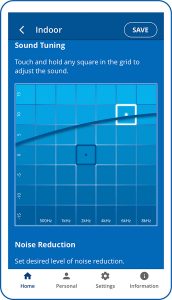
In noisy settings, use the app to set the level of background noise reduction. Also, customize what you hear in real time by selecting the Best Sound Point. Simply tap on different squares in the app’s grid until you achieve the best combination of frequency and amplitude for your current situation.
Need More Information?
Contact us here. If not, head over to our on-line store. Our 30-day return policy lets you purchase with confidence.
Active Noise Cancellation vs. Noise Reduction
What is the Difference, and Which Technology is Used in BeHear and Why?
Even before this article came out comparing the BeHear with Bose Hearphones we received inquiries about how our products enhance hearing in noisy places. There seemed to be some confusion about how two leading technologies – Active Noise Cancellation (ANC) and Noise Reduction – work in headphones in general, and whether they are used in the Wear & Hear line of assistive hearing products. Because ANC is a much-heralded feature in high-end Bluetooth headphones, many people were curious to know why we do not use it in our BeHear Bluetooth headset with personalized hearing enhancement. Our engineers have contributed the following texts in an attempt to clarify our choice.
How Does ANC Work?
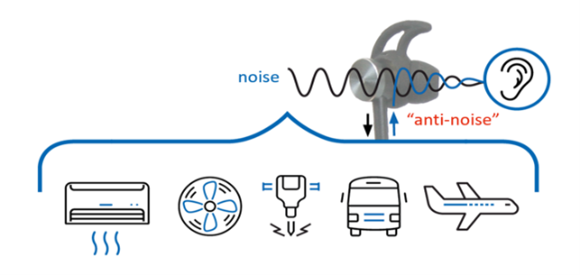
In the process of ANC a microphone is used to monitor the environmental noise in order to create an “opposite” sound wave with an inverted phase. This anti-wave is reproduced via the earpiece and mixed with the original acoustic sound wave to cancel out the noise before it reaches the user’s ear.
What Happens in the Hearing Enhancement Process?
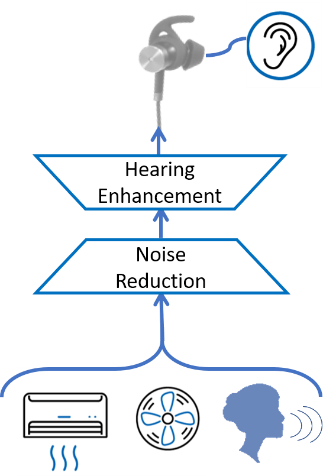
In the hearing enhancement process a microphone is also used to pick up the environmental sound. This sound is amplified based on the specific hearing requirements of the user and then the processed, slightly delayed output sound is reproduced via the earpiece.
As a result, this hearing-enhanced (amplified) sound actually masks the direct environmental sound wave causing the hearing-impaired user to hear mainly the enhanced sound reproduced by the earpiece, and not the acoustic waves coming from the environment.
Why ANC and Noise Reduction Cannot be Employed Simultaneously
The two methods – ANC and hearing enhancement – are conceptually contradictory. The conflict arises from both acoustic and methodology contradictions. Acoustically, since the same “monitoring” microphone is used by both the ANC and hearing enhancement technologies to pick up the environmental sound, the two signals – the immediate ANC anti-wave and the slightly delayed hearing-enhanced wave – may produce an unpleasant acoustic effect known in physics as “wave beats” when the two signals are mixed together in the user’s ear. Another conflict arises from the fact that one technology (ANC) tries to achieve noise reduction by sending the anti-wave, while the other (hearing enhancement) tries to substitute the direct acoustic sound with its enhanced and amplified version, making the ANC anti-wave obsolete.
For the reasons explained above, ANC is not applied in the BeHear headset. Instead, and in order to clarify the speech in noisy environments, BeHear applies a dedicated noise reduction technology to the hearing-enhanced sound, thus making the sound perceived by the user significantly less noisy. Additionally, BeHear allows the user to control the amount of noise reduction applied – a feature that is not available to users of ANC.
The Choice is Clear for Assistive Hearing Products
Bottom line:
We don’t think ANC is important for our target user given its irrelevance when combined with hearing enhancement technology. Furthermore, we didn’t want to increase the product price by introducing a feature that would increase the cost of the device without providing a substantial benefit to our users.
Alango Wear & Hear Development Team
For more information about our Wear & Hear line of assistive hearing products visit the products page of our Web site.
How to Know if BeHear NOW Suits Your Level of Hearing Loss
Have you invested in hearing aids, only to discover that they don’t suit you in every situation? Maybe they’re too uncomfortable to wear all day, or they don’t really help you at the theater or during a live concert? Perhaps they help amplify sound, but they don’t help you understand mobile phone conversations, or hear the dialogue on the television very clearly?
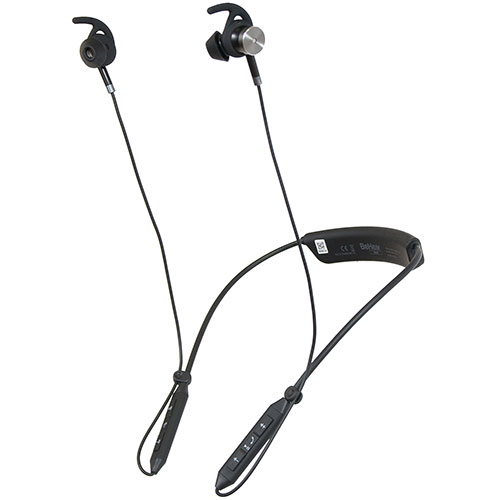
In these cases, you may be interested in trying BeHear NOW. This assistive hearing headset is not a medical device. Instead, it uses advanced sound processing technology, housed in a Bluetooth stereo headset, to enhance what you hear — whether it be live conversations, dialogue on the television, mobile phone calls — when you need it.
So, how do you know if a BeHear hearing amplifier would be right for you? We encourage you to try BeHear for yourself. We have a 30-day return policy, so if you’re not satisfied you simply return the product and get your money back.
What to Do Now
Go to our on-line shop and purchase a BeHear headset. Once you receive it you should go to the Google Play Store (for Android phones, version 4.4 and up) or the Apple Store (for iOS, version 9 and up) and download the free “W&H BeHear” app. You’ll use this app to pair your phone to the headset, and input the values from your audiogram (in the “Personal Info” section of the app). Once you finish, the headset will be updated automatically with custom parameters reflecting your hearing levels for the three hearing modes (ambient hearing, Bluetooth audio, and mobile phone calls). You can further customize the hearing presets (Indoor, Outdoor, Crowd and Live Music) in real-time using the app. View our library of “How to…” videos to learn how to use the headset.
If you’re still unsure…
We invite you to send us your audiogram and we will help determine if the BeHear hearing amplifier might be able to enhance your hearing.
Better Hearing is Now Within Reach – Part 3
This is the final installment of a 3-part series. If you haven’t yet read the earlier installments, you can read the first part here and the second part here.
How is this Concept Different from the Conventional Solutions?
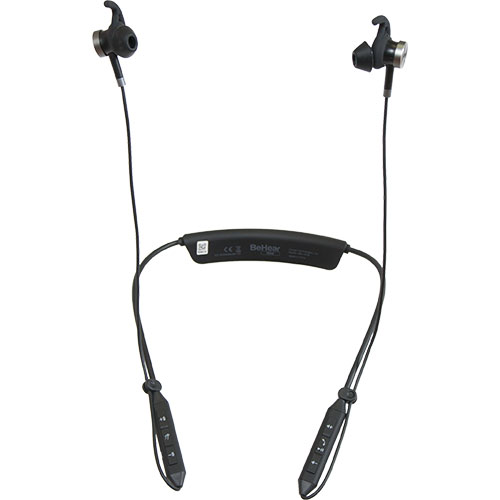
Our first personal hearing product, released commercially in the Fall of 2018, is called BeHear® NOW. It is a stylish, comfortable, high-quality Bluetooth stereo neckband style headset that can be used to listen to music or make phone calls. In addition, it can be used to enhance ambient hearing, very similar to or better than hearing aids. Its retail price of $249 ( €249) makes it very attractive to a wide population.
What About Sound Quality?
BeHear NOW has four microphones, two in the earpieces and two in the control boxes. Using four microphones enables unprecedented sound quality for both ambient hearing and voice communication. The headset features two 13mm hi-fi speakers delivering uncompromised sound. It includes a large rechargeable battery allowing the wearer to use its ambient hearing amplification during an entire day without recharging.
The Difference is in the Sound Enhancing Software
BeHear NOW can be used as a standalone hearing amplifier, but its true value comes with its software. It pairs with a dedicated, free smartphone application called W&H BeHear for iPhones and Android that enables full control and self-adjustment of the headset. When the personal hearing mode is activated, the wearer can choose the most suitable preset (Indoors, Outdoors, Crowd or Live Music). S/He can change noise reduction settings from low to maximum depending on the environment.
Fine Tune the Device on Your Own

One of the problems with hearing aids today is that they require professional fitting in an audiologist’s office. Given the large number of people who suffer from hearing loss worldwide, it should be apparent that there are not enough audiologists on earth to provide hearing aids to everyone who needs one, especially in rural, distant areas. With BeHear NOW that is not an issue. Wearers can modify the spectrum of the sound they hear in real time by moving their finger on a grid to locate what we call the Best Sound Point. The Best Sound Point is a highly personal definition, depending on the wearer’s preferences, capabilities, and current location!

Furthermore, the W&H BeHear application contains a simple hearing assessment that anyone can perform and get immediate results. This is not a medical procedure, of course, but when completed, all BeHear NOW sounds will be modified to fit the wearer’s own personal hearing profile.
Advantages That People With Normal Hearing Will Also Appreciate
BeHear NOW also includes some advanced features that may be useful for people with normal hearing as well. For example, many people have trouble with fast speech. We all prefer that the other person speak slower when we need to write down a phone number, understand a foreign language, or are otherwise being distracted. BeHear NOW can do it automatically. When BeHear NOW is used to make or take a phone call, the wearer can activate a special mode called EasyListen™ to slow down speech and improve understanding. While listening to music, the wearer can activate ListenThrough™ technology. Nearby human voices, the noise of an approaching car and other important or alarming sounds will pass through while ambient noise will be blocked, allowing him/her to enjoy the music to the fullest.
Use EasyListen on mobile calls to slow down speech and improve understanding. Stay safe and alert, even while using your mobile phone in noisy places.
Great Potential for Improving Quality of Life
The Wear & Hear line of assistive hearing products is highly innovative, leveraging two successful concepts (consumer electronics and sound technology advancements). The resulting solutions have the potential to improve quality of life for millions of people worldwide. As Helen Keller once famously remarked, when asked which sense was more important, vision or hearing: “Blindness cuts us off from things, but deafness cuts us off from people.” We want the world to sound better to all. With the aid of our personal hearing devices, people can reconnect socially, without the stigma or high cost of a medical hearing aid.
What’s Next? Feedback and Market Education
The first members of our Wear & Hear family of personal hearing devices are ready for purchase, here on our Web site, and through our international partner channel. However, the market needs educating. There are about 400 million people with disabling hearing loss who desperately need a solution, but they have no idea that there is a high-quality alternative to hearing aids. Our concept of affordable, stylish, multi-functional hearing enhancement solutions needs to capture the attention of both the hearing impaired and those who can help us bring them to market. Can you help?
Better Hearing is Now Within Reach – Part 2
This is the second installment of a 3-part series. If you haven’t yet read the first installment, you can read it here.
An Unorthodox Approach Brings Hope
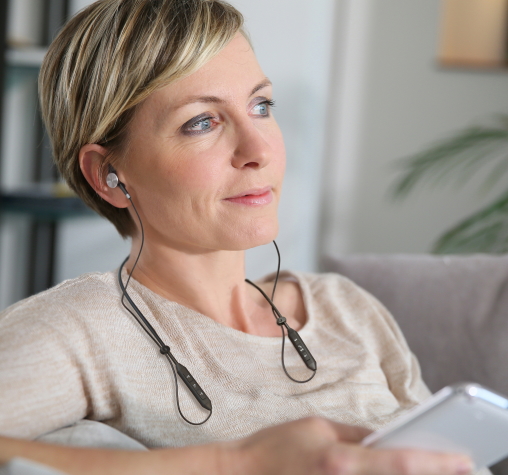
The development trend for hearing aids throughout history has been to make the devices smaller and less noticeable. We, on the other hand, wanted to make our hearing enhancement devices stylish, and even fashionable. Instead of making them expensive medical devices, we wanted to make them affordable consumer electronics devices. In addition, we wanted our devices to be high performance and multi-functional. And finally, we wanted our devices to act as hearing protectors by reducing loud ambient noises to safe levels.
Consumer Electronics Can Serve a Wider Purpose
We chose a Bluetooth headset as a basic form factor for our hearing enhancement device concept due to its ubiquity. Its cost of goods is low and public acceptability is high. In order to transform it into a powerful hearing enhancement device we first investigated its existing components, and found:
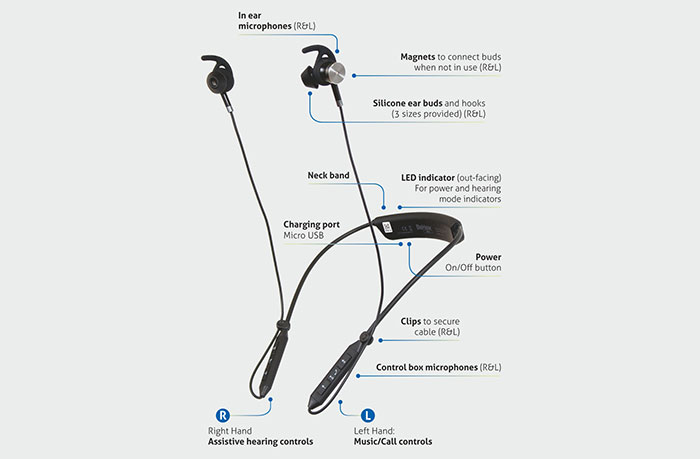
- At least one microphone. In many Bluetooth headsets we can find a dual microphone, something relevant to high end hearing aids only.
- A high-quality speaker that is much better than that of hearing aids, due to their size limitations.
- A Digital Signal Processor that is 4-5 times more powerful than that of most of hearing aids.
- Bluetooth connectivity present only in the latest, greatest and most expensive hearing aids
- An environmentally friendly rechargeable battery
The Missing Component: Hearing Enhancement Software

That means that there is only one important piece missing to transform ANY Bluetooth headset into a powerful hearing enhancement device. This piece is software. Just do it, and you have exciting news for more than 1 billion hearing impaired people world-wide. Since we are a software sound processing company, we did it! We created a licensable software reference design that makes it possible to add hearing enhancement functionality to virtually any Bluetooth headset. We call our solution Hearphones™.

In order to be sure that our solution was good, and that it really could help hearing impaired people as well as or better than hearing aids, we decided to go one step further. We decided to create our own brand of concept products that we call Wear & Hear, with our slogan “Life Sounds Better”.
How Does this Approach Compare to Conventional Solutions?
In the next post in this “Hearing Better is Now Within Reach” blog series, we’ll compare this unorthodox approach with the conventional solutions.
Better Hearing is Now Within Reach – Part 1
The Need, the Conventional Solution, and the Despair
The World Health Organization estimates that approximately 15% of the world’s population (that’s around 1.2 billion people!) suffers from hearing loss of greater than 25 decibels. Even though hearing loss is typically associated with old age, the majority of sufferers are under the age of 65. It is well known that hearing loss is a terrible experience for an individual and has multiple consequences. Children with hearing loss are likely to experience delayed speech development, impaired communication and reduced cognitive skills. In adults, hearing loss has been linked to poorer job performance and, as a result, lower salaries. In the elderly, hearing loss is associated with an increased risk of dementia, falls, depression, social isolation and loneliness. These problems impose a heavy financial burden on the society.
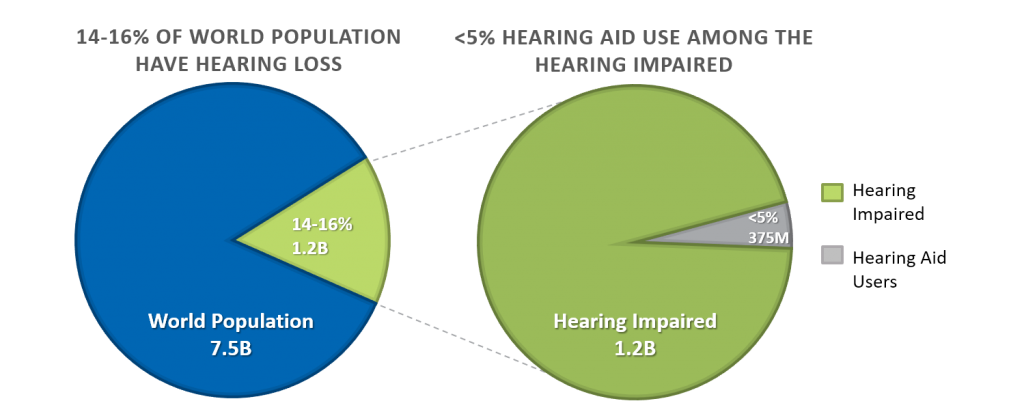
There is good news, though. Research shows that 95% of hearing impaired people can be helped by hearing amplification. The solution that jumps to mind immediately is hearing aids. Hearing aids have a long history: from hearing trumpets used over 100 years ago, through the development of the first wearable electronic devices, to the modern era of small, digital devices of various styles. Yet, hearing aids are used by less than 20% of hearing impaired people in developed countries, and less than 3% in low income countries. Why?
Why Aren’t More People Using Hearing Aids?
- Extremely high cost. A pair of hearing aids costs between $2000-$8000 dollars. Unless it is fully covered by insurance, it is not surprising that most people hesitate before buying them.
- Social stigma. Justified or not, people feel that wearing hearing aids will make them look older or handicapped. It is interesting that this feeling does not actually depend on the age. Many elderly people refuse to wear hearing aids. We all want to be young.
- Limited functionality. We’re used to multi-functional electronic devices that can do much more than just their main functionality. Smartphones are a classic example, but we have others, such as: radios, smartwatches or fitness bracelets. Basic, reasonably priced hearing aids can only do voice amplification.
- Performance. 20% of people who buy hearing aids return them. Although they are badly needed, these devices don’t help them. 17% of those who decide to keep their hearing aids are not satisfied.
What Can Be Done to Surmount These Obstacles to Better Hearing?
In the next post in this “Hearing Better is Now Within Reach” blog series, we’ll look at an unorthodox approach that addresses all four of these obstacles to bring hope to those experiencing mild to moderate hearing loss.

